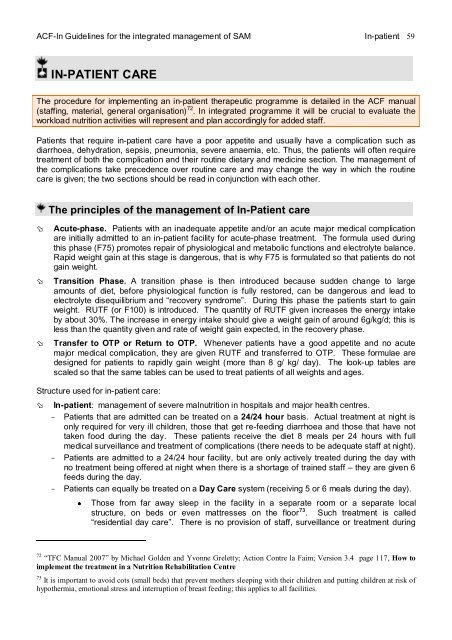guidelines for the integrated management of severe acute malnutrition
guidelines for the integrated management of severe acute malnutrition
guidelines for the integrated management of severe acute malnutrition
You also want an ePaper? Increase the reach of your titles
YUMPU automatically turns print PDFs into web optimized ePapers that Google loves.
ACF-In Guidelines <strong>for</strong> <strong>the</strong> <strong>integrated</strong> <strong>management</strong> <strong>of</strong> SAM In-patient 59<br />
IN-PATIENT CARE<br />
The procedure <strong>for</strong> implementing an in-patient <strong>the</strong>rapeutic programme is detailed in <strong>the</strong> ACF manual<br />
(staffing, material, general organisation) 72 . In <strong>integrated</strong> programme it will be crucial to evaluate <strong>the</strong><br />
workload nutrition activities will represent and plan accordingly <strong>for</strong> added staff.<br />
Patients that require in-patient care have a poor appetite and usually have a complication such as<br />
diarrhoea, dehydration, sepsis, pneumonia, <strong>severe</strong> anaemia, etc. Thus, <strong>the</strong> patients will <strong>of</strong>ten require<br />
treatment <strong>of</strong> both <strong>the</strong> complication and <strong>the</strong>ir routine dietary and medicine section. The <strong>management</strong> <strong>of</strong><br />
<strong>the</strong> complications take precedence over routine care and may change <strong>the</strong> way in which <strong>the</strong> routine<br />
care is given; <strong>the</strong> two sections should be read in conjunction with each o<strong>the</strong>r.<br />
The principles <strong>of</strong> <strong>the</strong> <strong>management</strong> <strong>of</strong> In-Patient care<br />
� Acute-phase. Patients with an inadequate appetite and/or an <strong>acute</strong> major medical complication<br />
are initially admitted to an in-patient facility <strong>for</strong> <strong>acute</strong>-phase treatment. The <strong>for</strong>mula used during<br />
this phase (F75) promotes repair <strong>of</strong> physiological and metabolic functions and electrolyte balance.<br />
Rapid weight gain at this stage is dangerous, that is why F75 is <strong>for</strong>mulated so that patients do not<br />
gain weight.<br />
� Transition Phase. A transition phase is <strong>the</strong>n introduced because sudden change to large<br />
amounts <strong>of</strong> diet, be<strong>for</strong>e physiological function is fully restored, can be dangerous and lead to<br />
electrolyte disequilibrium and “recovery syndrome”. During this phase <strong>the</strong> patients start to gain<br />
weight. RUTF (or F100) is introduced. The quantity <strong>of</strong> RUTF given increases <strong>the</strong> energy intake<br />
by about 30%. The increase in energy intake should give a weight gain <strong>of</strong> around 6g/kg/d; this is<br />
less than <strong>the</strong> quantity given and rate <strong>of</strong> weight gain expected, in <strong>the</strong> recovery phase.<br />
� Transfer to OTP or Return to OTP. Whenever patients have a good appetite and no <strong>acute</strong><br />
major medical complication, <strong>the</strong>y are given RUTF and transferred to OTP. These <strong>for</strong>mulae are<br />
designed <strong>for</strong> patients to rapidly gain weight (more than 8 g/ kg/ day). The look-up tables are<br />
scaled so that <strong>the</strong> same tables can be used to treat patients <strong>of</strong> all weights and ages.<br />
Structure used <strong>for</strong> in-patient care:<br />
� In-patient: <strong>management</strong> <strong>of</strong> <strong>severe</strong> <strong>malnutrition</strong> in hospitals and major health centres.<br />
- Patients that are admitted can be treated on a 24/24 hour basis. Actual treatment at night is<br />
only required <strong>for</strong> very ill children, those that get re-feeding diarrhoea and those that have not<br />
taken food during <strong>the</strong> day. These patients receive <strong>the</strong> diet 8 meals per 24 hours with full<br />
medical surveillance and treatment <strong>of</strong> complications (<strong>the</strong>re needs to be adequate staff at night).<br />
- Patients are admitted to a 24/24 hour facility, but are only actively treated during <strong>the</strong> day with<br />
no treatment being <strong>of</strong>fered at night when <strong>the</strong>re is a shortage <strong>of</strong> trained staff – <strong>the</strong>y are given 6<br />
feeds during <strong>the</strong> day.<br />
- Patients can equally be treated on a Day Care system (receiving 5 or 6 meals during <strong>the</strong> day).<br />
• Those from far away sleep in <strong>the</strong> facility in a separate room or a separate local<br />
structure, on beds or even mattresses on <strong>the</strong> floor 73 . Such treatment is called<br />
“residential day care”. There is no provision <strong>of</strong> staff, surveillance or treatment during<br />
72 “TFC Manual 2007” by Michael Golden and Yvonne Greletty; Action Contre la Faim; Version 3.4 page 117, How to<br />
implement <strong>the</strong> treatment in a Nutrition Rehabilitation Centre<br />
73 It is important to avoid cots (small beds) that prevent mo<strong>the</strong>rs sleeping with <strong>the</strong>ir children and putting children at risk <strong>of</strong><br />
hypo<strong>the</strong>rmia, emotional stress and interruption <strong>of</strong> breast feeding; this applies to all facilities.

















